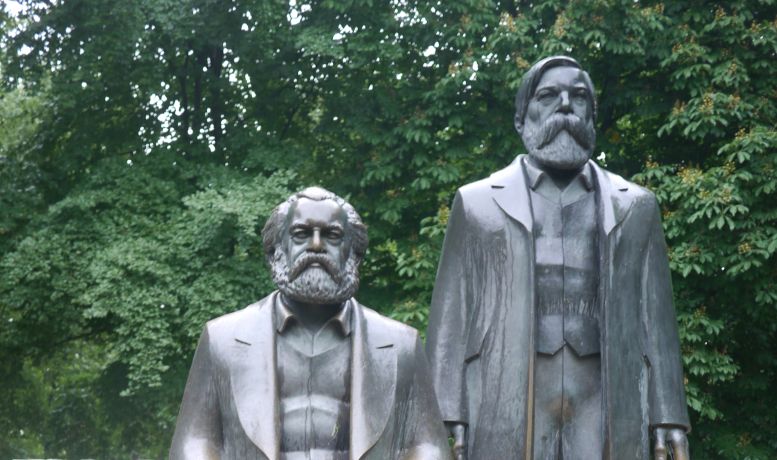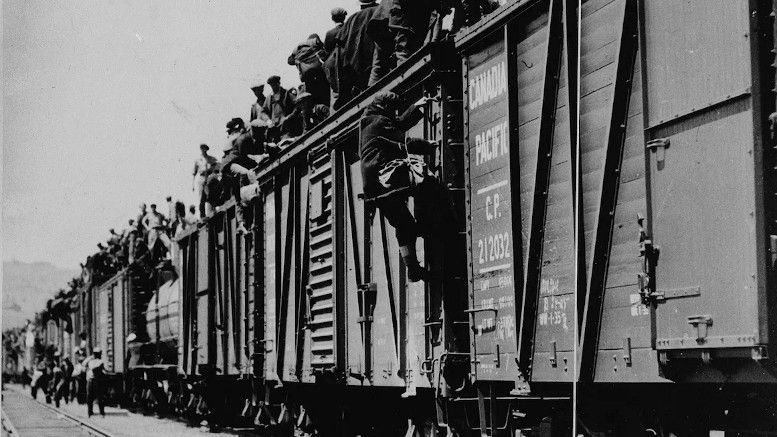by Karl Marx & Fredrich Engels
175 years ago, on February 21, 1848, The Communist Manifesto was published, opening the eyes of the world to ideas that would threaten the political basis of bourgeois society. A bombshell when it came out, it contains the germ of many key Marxist ideas and for the first time, expressed a clear formulation of what became known as Marxism. This historically important document was published as the platform of the Communist League and reflected the key ideas and central proposition formulated by Karl Marx and Frederick Engels over years of discussion, research and collaboration. At a Congress of the League, held in London in November 1847, Marx and Engels were commissioned to prepare a complete theoretical and practical party program.
By the time The Manifesto was published, communism was already acknowledged as a power in Europe and there were political opponents to these ideas. As its introduction says, “A spectre is haunting Europe — the spectre of communism. All the powers of old Europe have entered into a holy alliance to exorcise this spectre: Pope and Czar, Matternich [former Foreign Minister of the Austrian empire] and Guizot [former Prime Minister of France], French radicals and German police-spies.”
The manuscript was sent to the printer just weeks before the French revolution of February 24. Published in German, soon it was translated into multiple languages including French, English, Danish, and Polish. The French translation came out shortly before the defeated revolution of June 1848 — the first great battle between proletariat and bourgeoisie. After this defeat, the Communist League came under attack, members were arrested, several were imprisoned and then the League was formally dissolved.
Key Ideas
The Communist Manifesto advanced the key idea of class struggle as a historical process. Its opening line, “the history of all hitherto existing society is the history of class struggles,” tells written history through the eyes of workers. Unlike the history that is normally told through the lens of those at the top of society, The Manifesto firmly places the working class as a driving force in making history.
The Manifesto is both relevant and inspirational today. The Manifesto’s relevance grew over time as its ideas found a firm foothold in the lived reality of the working class. It became popular with the growth of socialism, starting in Europe, from the 1870s. Since the French Revolution, as The Manifesto predicted, capitalism reached every corner of the globe. After the Russian Revolution of 1917, it became a foundational text for Marxists, worldwide.
In Engels’ preface, he speaks of the fundamental proposition that forms the nucleus of the Manifesto that he said is “destined to do for history what Darwin’s theory has done for biology”:
“That in every historical epoch, the prevailing mode of economic production and exchange, and the social organization necessarily following from it, form the basis upon which it is built up, and from which alone can be explained, the political and intellectual history of that epoch; that consequently the whole history of mankind (since the dissolution of primitive tribal society, holding land in common ownership) has been a history of class struggles, contests between exploiting and exploited ruling and oppressed classes; that the history of these class struggles form a series of evolutions in which, nowadays, a stage has been reached where the exploited and oppressed class — the proletariat — cannot attain its emancipation from the sway of the exploiting and ruling class — the bourgeoisie — without at the same time, and once and for all, emancipating society at large from all exploitation, oppression, class distinctions and class struggles.”
This proposition, which places the social organization of society as stemming from its mode of production and exchange, and further leading to the view that this in itself explains the political history of the epoch, is now central to understanding Marxism. It is on this basis that we develop our perspectives today. And importantly, our perspectives reach the conclusion every time that the interests of workers and the ruling class are opposed, that the emancipation of the working class must come from struggle, and that we can only be free from oppression of all kinds — racism, sexism, ableism, transphobia, etc. — when we are freed from the grip of capitalism and the exploitation and imprisonment of class.
The Manifesto is an indictment of class society itself, not just of capitalism. It critiques the way that class divisions have been sewn into the fabric of society for millennia, creating a prison of oppression for many sections of humanity. It describes how modern bourgeois society “sprouted from the ruins of feudal society,” which in itself was ridden with class antagonisms. Bourgeois society established new classes and new conditions of oppression, creating two classes directly facing each other: bourgeoisie and proletariat. It describes how the bourgeoisie has “pitilessly torn asunder the motley feudal ties that bound man to his “natural superiors” and has left no other bond between man and man than naked self-interest, than callous “cash payment.” … It has resolved personal worth into exchange value, and in place of the numberless indefeasible chartered freedoms, has set up that single, unconscionable freedom — Free Trade.”
Capitalism was still in its infancy in 1848: only England and Belgium were industrialized. Yet, The Manifesto showed incredible foresight in its description of how capitalism was a system of inherent crises, foretelling the deliberate destruction of the means of production in order to increase profits.
The Manifesto describes how capitalism drove and in turn was accelerated by colonization, trade in commodities and the search for new markets. The restrictive guilds were taken over by mass, industrial production. As markets grew, demand rose and industry grew, as did the proletariat and the formation of a separate class. Workers were exploited. “These labourers, who must sell themselves piecemeal, are a commodity, like every other article of commerce, and are consequently exposed to all the vicissitudes of competition, to all the fluctuations of the market.”
The Manifesto also discusses the role of the family in bourgeois society saying it “has torn away from the family its sentimental veil and has reduced the family relation to a mere money relation.” In the industrial era, child labour was common, and The Manifesto criticizes how in modern industry “all family ties are torn asunder, and their children transformed into simple articles of commerce and instruments of labour.” Women, in bourgeois society, are viewed as “mere instruments of production.” These ideas around the role of the family are later developed by Engels in his 1884 book, The Origin of the Family, Private Property and the State.
Other key ideas, developed in other Marxist writings, describe how the modern bourgeoisie advanced its political clout through the creation of a modern state, whose executive is “but a committee for managing the common affairs of the whole bourgeoisie.” This idea is one that provides Marxists with a clear perspective on the state and who it really represents. After the defeat of the Paris Commune in 1871, it became clear that the working class cannot use the existing state machine to achieve its goals. This idea was expanded on by Lenin, in State and Revolution.
Even Chapter 3 of The Manifesto, which describes a range of variants of socialism — including Petty Bourgeois Socialism, German or “True” Socialism, Conservative or Bourgeois Socialism, Critical-Utopian Socialism and Communism — has some relevance today. Although these specific forms of socialism are no longer around, we can critique variants of social democratic reformism, ultra-leftism and others. A key point is that there is no substitute for mass struggle and building movements to overthrow capitalism.
Historical Significance
The fact that, 175 years later, International Socialist Alternative is writing about this book speaks to its continuing significance and relevance. We remain in a society that is riddled with oppression. The proletariat today is still facing the same basic oppression as described in The Manifesto.
Aside from the ideas about class, wage-labour, oppression, the working class and struggle, what makes The Communist Manifesto so powerful is its stark and poetic description of the inhumanity of this brutal system. The power of its writing is part of its attraction.
The Communist Manifesto does not just provide an analysis — it provides a set of demands, a prescription. Its demands include:
- The Abolition of private property.
- A progressive or graduated income tax.
- Abolition of inheritance rights.
- Centralization of credit in the hands of the state, by means of a national bank with state capital and an exclusive monopoly.
- Centralization of the means of communication and transport in the hands of the state.
- Free education for all children in public schools. Abolition of child factory labour.
- Extension of factories and instruments of production owned by the state; the bringing into cultivation of waste lands, and the improvement of soil generally in accordance with a common plan.
The Manifesto says that “of all the classes that stand face to face with the bourgeoisie today, the proletariat alone is really a revolutionary class.” That is also true, although many workers today still do not understand their own power.
The Manifesto describes how workers can use their power and how “Communists everywhere support every revolutionary movement against the existing social and political order of things. In all these movements they bring to the front, as the leading question, in each case, the property question, no matter what its degree of development at the time.”
Importantly, The Manifesto refers to the political supremacy of the proletariat, who do not have a country of their own. The very idea of internationalism and the concept of international unity is introduced — “they labour everywhere for the union and agreement of the democratic parties of all countries.”
Finally, The Manifesto says that the Communists are open about their views and aims. They make clear that their ends “can only be attained by the forcible overthrow of all existing social conditions. Let the ruling classes tremble at a Communist revolution.”
The Manifesto says that “The ruling ideas of each age have been the ideas of its ruling class.” The Manifesto itself challenges this by providing an important counter-narrative to the ruling ideas, and these remain relevant in today’s new era of capitalism.
The concluding sentence of The Manifesto is as true today as it was when it was written in 1848: “Workers have nothing to lose but their chains. They have a world to win. Workers of the world unite!”




